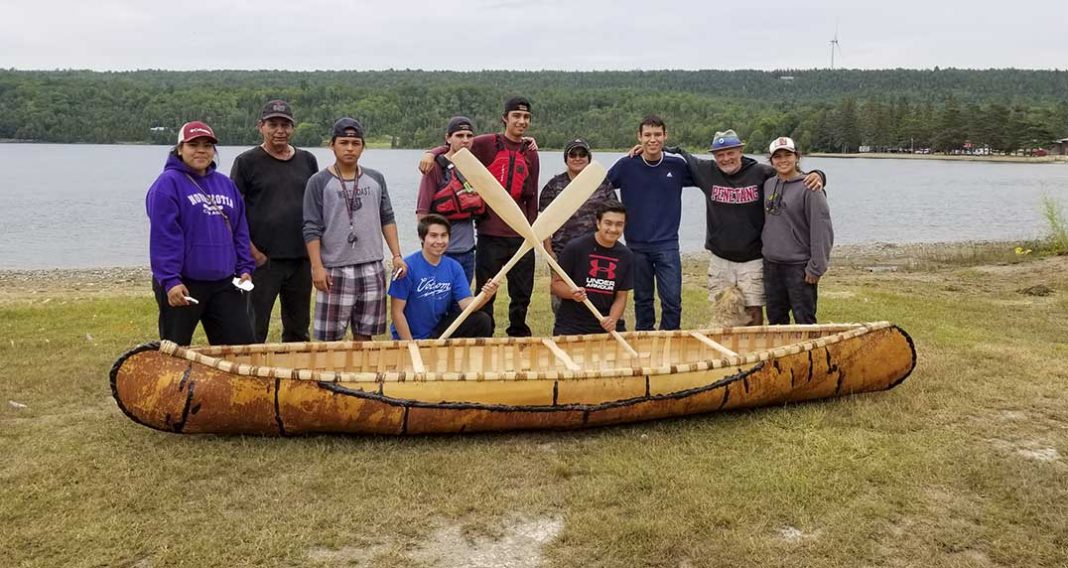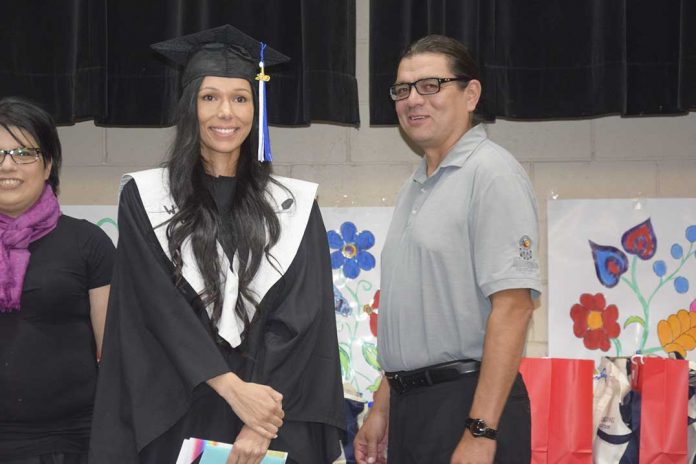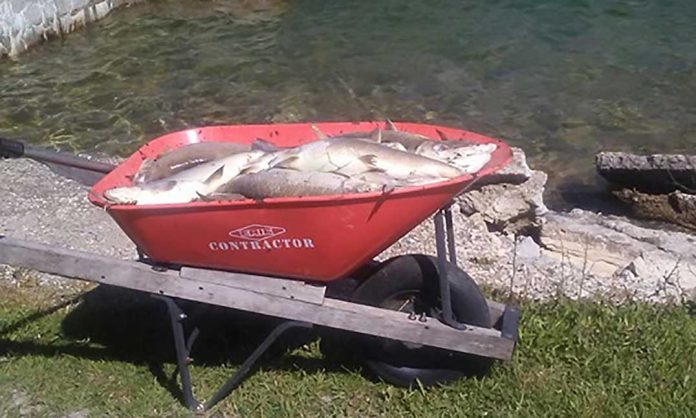M’CHIGEENG – The anticipatory tension at the West Bay beach in M’Chigeeng First Nation was shattered with an outburst of applause as the first-ever handmade birchbark canoe to come from Kenjgewin Teg dipped onto the surface of the water and floated with ease, just as its predecessors had done for millennia.
“This is a lost art. We wanted to give this knowledge back to the community,” said Linda Mathews of Blackwolf Bark Canoes. She and Wayne Bayer were at the public launch event to represent Blackwolf Bark Canoes, the outfit which worked with Kenjgewin Teg’s Anishinabek Youth Ambassadors as the traditional knowledge keepers and mentors while creating this watercraft. Craig Fox also offered expertise on the project.
The Anishinabek Youth Ambassador (AYA) program is a summertime Kenjgewin Teg initiative designed to foster leadership skills, cultural knowledge and personal growth in participants between the ages of 16 and 24.
The AYA program runs for 30 hours per week and participants earn a moderate salary of $14 per hour for taking part. Its promotional flyer bills the opportunity as a “hands-on, experiential learning approach that brings out all the gifts of the participants to share and learn from in a safe, yet challenging environment.”
It seeks to encourage cultural resilience, cultural identity and self-confidence that will ground the young participants in their identity by addressing their spiritual, emotional and physical well-being.
Kenjgewin Teg dean of pathways Mark Gibeault said the program co-ordinators were looking for a course that bridged trades education with traditional knowledge, which would culminate in the students receiving a high school credit.
“The canoe build was a great fit for our manufacturing technologies course,” said Mr. Gibeault.
“It’s quite a tribute to their heritage and gives them a real sense of accomplishment to take on an idea like this and bring it to fruition,” said course instructor Jason Thibault. “That canoe is hundreds of years in the making.”
Mr. Thibault explained that the TMJ2O manufacturing technology course is typically not offered at schools because they often don’t contain the facilities to design and fabricate relevant projects. For this course, the students were divided into two teams of five. In the mornings one team worked on the canoe while the other learned welding fundamentals as they put together piggy banks. They switched halfway through the day.
“This canoe was about three weeks in the making. There’s probably 40 ribs in the structure of the boat,” said Mr. Thibault.
To speak to Anishinaabe traditional teachings, the students did not use any power tools during the build. They split and shaved down their cedar frame pieces using a drawing knife, used spruce root as lashing to affix the outer shell to the frame and used pine gum as an adhesive to join pieces and seal any perforations.
The boat hit the water two days prior to test its seaworthiness before the public was invited to the official launch on Friday, July 26. Elder Jean Debassige offered an opening prayer and was even wearing a canoe-themed shirt to commemorate the occasion.
Ms. Mathews said she hoped the students would keep passing along the knowledge they had received to future generations and that some people had already expressed an interest in building their own.
“Our people need to know that Indigenous people were creators and scientists, too. They understood hydrodynamics,” added Mr. Gibeault. “The canoe is still a very useful craft for navigating Canada’s waters.”
Student participants Maverick Bushey and Cordell White shared some of the traditional teachings they had gained through the course, including how canoes are connected to humans because the boat’s ribs are similar to those inside one’s chest, and how the roots tying the boat together were like the veins running throughout one’s body.
“It was interesting and a fun project to learn,” said Maverick, adding that the experience developed his skills of patience and trust. Seeing so many community members present to celebrate the boat’s launch was significant, too.
“It feels good and it brings up that fire within,” the 17-year-old MSS student said.
Cordell agreed that the project taught the class a lot about their culture.
“It brought us all a lot closer together, like a family,” he said.
Cordell is going into a pre-trades program this fall in Sudbury. He said this program taught him a lot about planning complex projects such as the canoe build and will help him in his pursuit of a carpentry career.
A birchbark canoe is a rare item in the modern age, and even seasoned paddling veteran Mr. Gibeault agreed that this was a unique opportunity.
“I’ve been wanting to paddle a birchbark canoe my whole life, especially one that I knew everyone who put the work into building it,” he said with a wide smile. “This was a bucket list item for me.”





